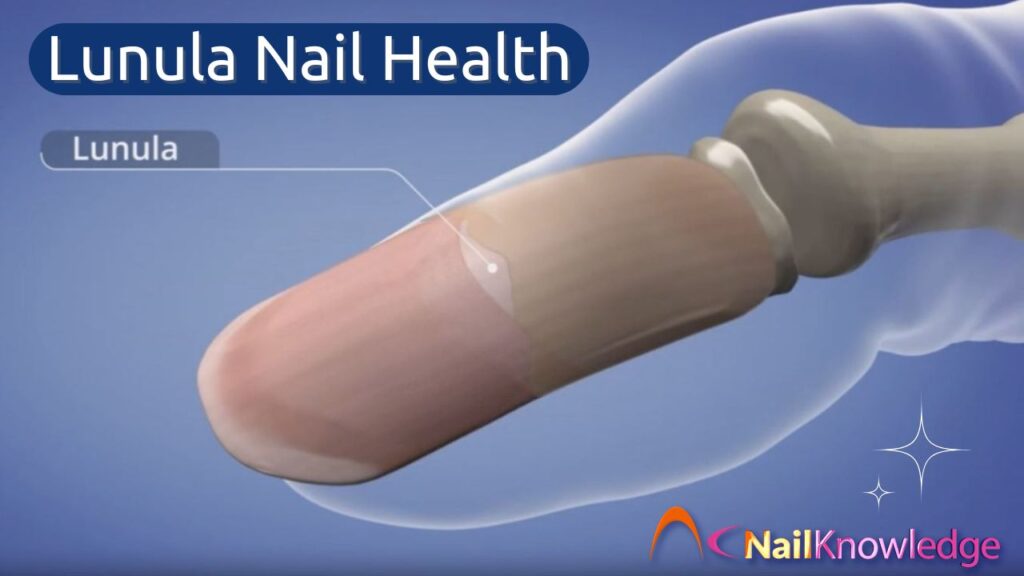Do You Need the White Crescent to Have Healthy Nails?
When people look closely at their nails, they often notice the pale white crescent at the base called the lunula. Some proudly point out their “moons,” while others worry if they are hidden. Online, there are endless claims linking lunula nail health to overall wellbeing, such as “If you do not have lunulae, you are unhealthy” hoặc “Missing moons mean vitamin deficiency.”
As nail professionals, we know that not everything online is true. Let us set the record straight: every person has a lunula, visible or not, and its presence has nothing to do with health or nutrition deficiencies.
What is the Lunula and Why it Matters for Lunula Nail Health
The word lưỡi liềm comes from the Latin luna, meaning moon. It is the whitish crescent that can sometimes be seen at the base of the nail plate, most prominently on thumbs. This lighter shade is caused by immature nail cells that have not fully hardened.
Far from being just decorative, the lunula is the visible part of the ma trận móng tay, the living tissue responsible for creating new nail cells. The matrix is like the nail’s factory, constantly producing keratinocytes that form the nail plate.
Lunula Nail Health: Why Some Nail Moons Are Visible and Others Are Not
A hidden lunula does not mean something is wrong. Dermatologists use the term anolunula when the lunula is not visible. It is a normal variation, not a diagnosis.
Visibility depends on factors such as:
- Skin tone: Lunulae are easier to spot on lighter skin, less so on darker skin.
- Age: Children’s lunulae often look larger and more obvious. With age, they may shrink or become hidden.
- Finger differences: Lunulae are typically most obvious on thumbs and often not visible on little fingers.
In short, whether you see them or not is a matter of biology, not overall lunula nail health.
The Myth of Lunula Nail Health as a Health Indicator
One of the most persistent myths is that missing lunulae point to illness, poor circulation, or vitamin deficiency. Supplement companies often use this misconception to market “nail health boosters.”
The truth: You always have lunulae. If you cannot see them, they are simply hidden under the proximal nail fold. That has nothing to do with diet or overall health.
Nail professionals play an important role in busting this myth. Explaining the real science to clients builds credibility and reassures them.
When Changes in the White Crescent Could Matter
Although visibility is not an indicator of health, sudden changes in lunula size, color, or shape can sometimes signal medical issues. Examples include:
- Bluish lunula: may indicate low blood oxygen.
- Red lunula: sometimes linked to cardiovascular conditions or autoimmune diseases.
- Overly large lunula: occasionally seen with anemia or alopecia areata.
These cases are exceptions. As a nail professional, you are not diagnosing, but you can recommend a client see a doctor if you notice rapid, unexplained changes.
Common Client Questions About Lunula Nail Health
- If I do not see lunulae, will they ever appear? Possibly. As nails grow and the proximal nail fold recedes slightly, lunulae may become visible, but their presence or absence has no impact on nail health.
- Why do I see them on one hand but not the other? This is normal. Dominant hands often show differences in nail growth patterns and appearance.
- Can I make my lunulae bigger? No. Lunula size is genetic. Products that claim to “restore moons” are simply marketing myths.
Why This Matters for Nail Professionals
Your clients may arrive anxious, having read online claims that connect nail moons to serious health conditions. When you confidently explain the facts, you:
- Build trust by correcting misinformation.
- Demonstrate professional expertise grounded in science.
- Show commitment to client safety by knowing when to refer concerns to medical professionals.
Educating clients not only reassures them but also positions you as a knowledgeable, reliable professional.
The Takeaway on Lunula Nail Health
The lunula is simply part of the nail matrix, sometimes visible and sometimes not. Its absence from view is perfectly normal and not a red flag for poor health.
What matters most is how nails grow, how they are cared for, and whether sudden changes occur. Nail professionals who understand the science and can communicate it clearly help protect clients from misinformation and unnecessary worry.
So next time a client asks, “Why do I not see moons on my nails?” you will know exactly how to answer:
- Everyone has lunulae.
- Visibility varies naturally.
- Only sudden changes matter.
By sharing knowledge with confidence, you are not just polishing nails, you are strengthening your reputation as an expert in lunula nail health and client education.


